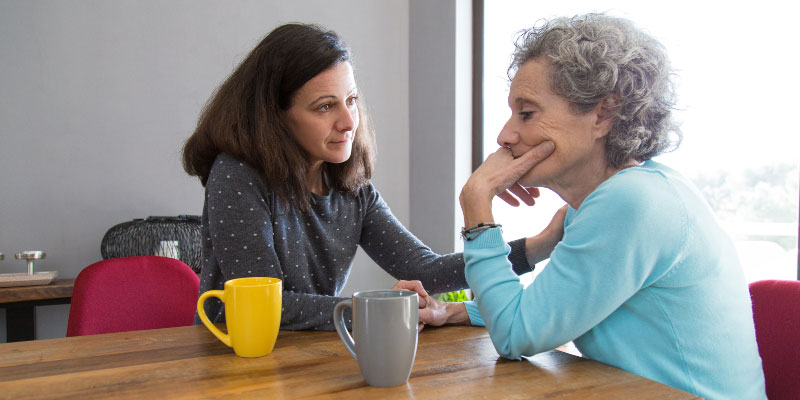There are times in our lives where we feel stressed and anxious, and while this is normal, consistent feelings associated with anxiety are unhealthy and can disrupt the lives of people experiencing them.
While anxiety disorders tend to develop in childhood, adolescence, or early adulthood, they can develop at any age, and they are chronic, life-long illnesses that can greatly affect the quality of life for people living with them. Seniors with anxiety disorders may have struggled their whole lives or developed anxiety as a response to recent trauma or loss, or have symptoms of a mild case worsened by medications, chronic pain, and neurodegenerative diseases like dementia and Alzheimers.
What is an Anxiety Disorder?
Anxiety, in general, is persistent and excessive worry. We often feel anxious before activities like performing in front of a crowd or when we’re going through difficult times in our lives, but anxious behaviors are a cause for concern when they occur outside stressful situations, persist for more than three weeks, or affect one’s ability to go about their normal day. Anxiety disorders come in many forms, and symptoms often overlap between types of anxiety. While the following are common types of anxiety, the list is not exhaustive, and anxiety can present very differently from person to person.
Generalized Anxiety Disorder (GAD)
The Anxiety and Depression Association of America (ADAA) defines generalized anxiety disorder as, “persistent and excessive worry about a number of different things.” Generally, people with GAD are likely to anticipate disaster, worry more about situations than seems warranted, or chronically anticipate the worst possible outcome. People with GAD struggle to control their worry more often than not, and they often struggle with uncertainty and may plan situations as much as possible to try and prevent uncertainties.
Individuals with mild or moderate GAD usually still lead meaningful lives, but they can turn down opportunities or avoid certain situations because of their worry that affects their overall quality of life.
Panic Disorder or Panic Attacks
Panic is a common symptom of many anxiety disorders, but panic disorder is classified separately from others. The ADAA defines panic disorder as, “experiencing spontaneous, seemingly out-of-the-blue panic attacks and...fear of a recurring attack.”
The difference between a panic attack caused by panic disorder and an attack from another type of anxiety is the spontaneity of attacks. They can occur without much reason, sometimes upon waking up. Individuals with other types of anxiety, like GAD or post-traumatic stress disorder, often have identifiable triggers for attacks.
Panic attacks are often different from person to person. Review the common symptoms of a panic attack in this article.
Social Anxiety
Social anxiety is more than being nervous to meet new people or to present in front of a crowd. The ADAA defines social anxiety as “intense anxiety or fear of being judged, negatively evaluated, or rejected in a social or performance situation.” Individuals struggling with social anxiety worry their peers will find them boring, awkward, or less intelligent, or that they will appear visibly nervous. Individuals often avoid social situations or can have a panic attack when faced with unavoidable situations.
In seniors, social anxiety might develop as a response to loss of mobility or independence that can cause feelings of inadequacy. However, socialization is important for physical and mental health, especially for seniors.
Obsessive-Compulsive Disorder (OCD)
Obsessive-compulsive disorder (OCD) is defined by the American Psychiatric Association (APA) as, “recurring, unwanted thoughts, ideas or sensations (obsessions) that make [an individual] feel driven to do something repetitively (compulsions).” While most of us have some repetitive behaviors, people with OCD have unwanted routines or behaviors that disrupt their daily lives and they struggle to control it.
In severe cases, repetitive behaviors, called rituals, can take up a person’s entire day. Most people with OCD are aware that their intrusive thoughts are irrational, but they can’t control them or the compulsions associated with them, causing anguish.
The APA reports that the average for symptoms to occur in individuals with OCD is 19, but they begin at any point in life.
Post-Traumatic Stress Disorder (PTSD)
PTSD is probably the anxiety disorder most associated with the elderly, and particularly in war veterans. Originally called “shell shock” after World War I, PTSD develops following the experience of a traumatic event. Experiencing combat, an act of terrorism, a natural disaster, assault, or a serious accident can cause PTSD. It’s defined by the APA as, “intense, disturbing thoughts and feelings related to [an individual’s] experience that last long after the traumatic event has ended.”
Flashbacks and nightmares as well as feeling estranged from others are common symptoms of PTSD. While fear and anxiety are common immediately following a traumatic event, PTSD lasts for months or years after the experience and interferes in a person’s life. Repeated exposure to trauma, such as in military and emergency services, can increase the risk of developing PTSD.
Anxiety in Seniors
Originally, doctors thought anxiety disorders decreased with age; however, they’ve recently discovered this is not the case. Seniors are less likely to report psychiatric symptoms and more likely to focus on physical symptoms, like pain. Anxiety disorders occur in seniors at about the same frequency as they do in younger populations, which is about 3% of people for GAD.
However, seniors have many triggers for anxiety as a result of aging. Loss of independence can trigger social anxiety, while financial struggle and declining health or mobility can contribute to excessive worrying about the future, particularly after one’s death. Loss of loved ones, grief and isolation, as well as developing neurodegenerative disorders, can all contribute to anxiety disorders.
Seniors may also be more resistant to admitting to anxious feelings than other generations. Stigma on many mental health disorders, including anxiety, has changed a lot in the last several years, but seniors may still feel embarrassed to admit something is wrong.
Helping Senior Loved One Manage Anxiety
If you think your loved one may be struggling with excessive and persistent worry, or they are avoiding activities they used to enjoy, there are a lot of ways you can find help. Asking your loved one if they’ve felt more anxious, stressed, or worried lately and why can help identify what may or may not be excessive.
Start with Their Primary Care Physician
If your loved one has been seeing the same primary care physician for awhile, they’re more likely to trust this person than going straight to mental health professional. Talking with someone they already trust with their care improves their likelihood of accepting a referral to a mental health specialist.
Additionally, symptoms of anxiety and panic attacks can overlap with other serious health concerns, especially as we age. Headaches, rapid heartbeat, and back pain might be signs of anxiety or a physical condition. Anxiety and dementia also have overlapping symptoms, like irrational fears or behaviors. Starting with your loved one’s primary care physician can help determine the root cause of the symptoms.
Stay Supportive
Support is vital to helping loved ones with anxiety and other mental health concerns. Your loved one, their physician, and your family must all agree on the same problem and commit to treatment to see success.
Medications
There are a variety of medications that can be prescribed to lessen the symptoms of anxiety disorders. Medications are often prescribed to seniors at lower doses to account for changes in drug absorption as we age. Additionally, medication does not have to be a permanent solution. Often, medications can be temporary while your loved one comes to better understand their anxiety and find positive coping strategies.
Psychotherapy
Also referred to as “talk therapy,” psychotherapy is a common treatment for anxiety disorders at all ages. Talking with a mental health professional helps identify triggers and coping strategies to lessen the impact of anxiety. For individuals with PTSD, psychotherapy can also help process the traumas they’ve experienced.
Coping Strategies
Anxiety often causes us to feel overwhelmed at best or panic at worst. Coping strategies help individuals with anxiety take a step back and calm irrational or excessive thoughts. Some common coping strategies for anxiety disorders are:
- Deep breathing exercises
- Questioning irrational thoughts or replacing irrational thoughts with rational ones
- Journaling, or writing down your thoughts
Adding mindfulness practices into your loved one’s routine can help lower anxiety overall. Some common mindfulness practices are activities like meditation and prayer as well as relaxing yoga flows and tai chi. There are plenty of guided meditations and yoga or tai chi flows available online to try with your loved one.
Anxiety disorders can affect us at any age, but there are ways to manage anxiety so it doesn’t interfere with our daily lives. If you are worried that your loved one is struggling with anxiety and not sure how to help, the Substance Abuse and Mental Health Services Administration has a helpline for information, referral services, and connections to support groups and community organizations who can help.





